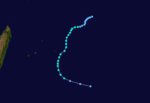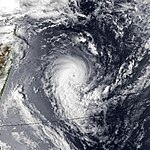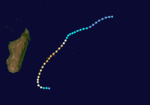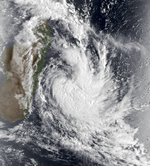| Revision as of 18:36, 2 July 2013 editHurricanehink (talk | contribs)Administrators61,978 edits Pearl-Farah re-written← Previous edit | Revision as of 18:45, 2 July 2013 edit undoHurricanehink (talk | contribs)Administrators61,978 edits →Severe Tropical Storm Edmea: writeNext edit → | ||
| Line 158: | Line 158: | ||
| |Pressure=976 | |Pressure=976 | ||
| }} | }} | ||
| The intertropical convergence zone spawned a low pressure area south of the Chagos archipelago on January 12, and developed a large area of convection the next day.<ref name="report"/> On January 13, MFR began classifying the system as a tropical depression, | |||
| <ref name="ebt">{{cite report|author=Knapp, K. R.|author2=M. C. Kruk|author3=D. H. Levinson|author4=H. J. Diamond|author5=C. J. Neumann|year=2010|work=The International Best Track Archive for Climate Stewardship (IBTrACS): Unifying tropical cyclone best track data|title=1994 Edmea (1994012S09075)|publisher=Bulletin of the American Meteorological Society|accessdate=2013-07-02|url=http://atms.unca.edu/ibtracs/ibtracs_v03r04/browse-ibtracs/index.php?name=v03r04-1994012S09075}}</ref> and following further intensification, the agency upgraded the depression to Moderate Tropical Storm Edmea later that day. With a ridge to the southeast, the storm tracked generally to the southwest. Its initial strengthening rate slowed until Edmea reached peak winds of 95 km/h (60 mph on January 17. An approaching trough turned the storm to the south away from any landmasses, and also increased shear which caused weakening. Turning to the southeast on January 18, Edmea became extratropical the following day and was later absorbed by the trough.<ref name="report"/> | |||
| {{clear}} | {{clear}} | ||
Revision as of 18:45, 2 July 2013
| 1993–94 South-West Indian Ocean cyclone season | |
|---|---|
 Season summary map Season summary map | |
| Seasonal boundaries | |
| First system formed | November 9, 1993 |
| Last system dissipated | April 17, 1994 |
| Strongest storm | |
| Name | Geralda |
| • Maximum winds | 205 km/h (125 mph) (10-minute sustained) |
| • Lowest pressure | 905 hPa (mbar) |
| Seasonal statistics | |
| Total disturbances | 15 |
| Total depressions | 15 |
| Total storms | 14 |
| Tropical cyclones | 8 |
| Intense tropical cyclones | 4 |
| Total fatalities | total |
| Total damage | Unknown |
| Related articles | |
| South-West Indian Ocean tropical cyclone seasons 1991–92, 1992–93, 1993–94, 1994–95, 1995–96 | |
The 1993–94 South-West Indian Ocean cyclone season was an event in the annual cycle of tropical cyclone formation. It began on November 15, 1993, and ended on April 30, 1994, with the exception for Mauritius and the Seychelles, for which it ended on May 15, 1994. These dates conventionally delimit the period of each year when most tropical cyclones form in the region. The basin is defined as the area west of 90°E and south of the Equator in the Indian Ocean, which includes the waters around Madagascar westward to the east coast of Africa. Tropical cyclones in this basin are monitored by the Regional Specialised Meteorological Centre in Réunion.
Seasonal summary

Storms
Moderate Tropical Storm Alexina
| Moderate tropical storm (MFR) | |
| Tropical storm (SSHWS) | |
  | |
| Duration | November 9 – November 14 |
|---|---|
| Peak intensity | 85 km/h (55 mph) (10-min); 982 hPa (mbar) |
On November 7, thunderstorms developed within an area of low pressure east of the Chagos Archipelago. The low gradually strengthened into a tropical depression on November 9. By the next day, the depression had strengthened into Moderate Tropical Storm Alexina, the first of the season. A small central dense overcast developed and the storm reached a peak intensity of 50 miles per hour (80 km/h) according to RSMC La Reunion. As high pressure built to the south of the cyclone on November 11, Alexina slowed down. As it did so, it also weakened due to stronger wind shear. The system weakened into a tropical depression and dissipated on November 16.
Severe Tropical Storm Bettina
| Severe tropical storm (MFR) | |
| Tropical storm (SSHWS) | |
  | |
| Duration | November 25 – December 2 |
|---|---|
| Peak intensity | 110 km/h (70 mph) (10-min); 970 hPa (mbar) |
On November 23, an area of low pressure developed in the far northeastern corner of RSMC La Reunion's area of responsibility. Two days later, intensification became evident when the low was located to the north of a large area of high pressure extending from Madagascar to the west coast of Australia. At 1800 UTC on November 25, RSMC La Reunion stated that a tropical depression had formed. Fast intensification occurred, and the depression had strengthened into Moderate Tropical Storm Bettina only six hours later. Bettina attained its peak intensity with winds near 110 km/h (70 mph) on November 27 at 1200 UTC. A small eye was also apparent during the afternoon of the same day. After the peak, strong vertical wind shear made Bettina weaken rapidly from November 28. The low level circulation center was still visible on November 29, however, deep convection had dissipated. The weakening storm moved around the anticyclone located in the far southern Indian Ocean. On December 1, Bettina briefly intensified into a tropical depression. It quickly weakened back into a remnant low and dissipated on December 3.
Severe Tropical Storm Cecilia
| Severe tropical storm (MFR) | |
| Category 2 tropical cyclone (SSHWS) | |
  | |
| Duration | December 12 – December 21 |
|---|---|
| Peak intensity | 100 km/h (65 mph) (10-min); 972 hPa (mbar) |
Tropical Cyclone Daisy
| Tropical cyclone (MFR) | |
| Category 2 tropical cyclone (SSHWS) | |
  | |
| Duration | January 7 – January 16 |
|---|---|
| Peak intensity | 155 km/h (100 mph) (10-min); 935 hPa (mbar) |
When Daisy struck Madagascar, it produced 200 km/h (120 mph) wind gusts on Île Sainte-Marie, along with heavy rainfall. The storm destroyed over 90 schools and government buildings and damaged the road network. Madagascar's capital Antananarivo was flooded, forcing 6,000 people to evacuate.
Severe Tropical Storm Edmea
| Severe tropical storm (MFR) | |
| Tropical storm (SSHWS) | |
  | |
| Duration | January 13 – January 19 |
|---|---|
| Peak intensity | 95 km/h (60 mph) (10-min); 976 hPa (mbar) |
The intertropical convergence zone spawned a low pressure area south of the Chagos archipelago on January 12, and developed a large area of convection the next day. On January 13, MFR began classifying the system as a tropical depression, and following further intensification, the agency upgraded the depression to Moderate Tropical Storm Edmea later that day. With a ridge to the southeast, the storm tracked generally to the southwest. Its initial strengthening rate slowed until Edmea reached peak winds of 95 km/h (60 mph on January 17. An approaching trough turned the storm to the south away from any landmasses, and also increased shear which caused weakening. Turning to the southeast on January 18, Edmea became extratropical the following day and was later absorbed by the trough.
Tropical Cyclone Pearl–Farah
| Tropical cyclone (MFR) | |
| Category 1 tropical cyclone (SSHWS) | |
  | |
| Duration | January 18 (entered basin) – January 21 |
|---|---|
| Peak intensity | 120 km/h (75 mph) (10-min); 960 hPa (mbar) |
On January 11, a tropical low formed northwest of Broome, Western Australia. It was named Pearl a few hours later by the Bureau of Meteorology. The cyclone continued westward and reached a peak intensity of 155 km/h (100 mph). As the system moved west of 90°E, MFR took over warning responsibility on January 18 and renamed the cyclone Farah. At that time, the storm had 10 minute winds of about 120 km/h (75 mph). After having moved westward due to a ridge to the south, Farah turned to the south upon entering the basin due to an approaching trough, which previously absorbed Edmea. High wind shear caused rapid weakening, and by January 19, there was little remaining convection. The next day, Farah weakened to tropical depression status and turned to the southeast. The ridge built behind the trough, causing the depression to stall and drift northward, and by February 22, Farah dissipated.
Intense Tropical Cyclone Geralda
| Intense tropical cyclone (MFR) | |
| Category 5 tropical cyclone (SSHWS) | |
  | |
| Duration | January 26 – February 8 |
|---|---|
| Peak intensity | 205 km/h (125 mph) (10-min); 905 hPa (mbar) |
Cyclone Geralda, the strongest of the season and the strongest to hit Madagascar since a cyclone in March 1927. It originated from an area of low pressure from the monsoon trough on January 25. Over the following few days, the depression underwent gradual intensification, reaching its peak intensity with 10-minute sustained winds of 200 km/h (125 mph) on January 31. Cyclone Geralda made landfall near Toamasina, Madagascar after weakening from its peak intensity. Within hours of moving onshore, the system had substantially weakened, and by February 5, Geralda had degenerated into a land depression. After briefly emerging into the Mozambique Channel, Geralda crossed southern Madagascar, and it became extratropical on February 8.
Geralda was the second cyclone in as many months to strike eastern Madagascar, after Daisy in January. Geralda produced wind gusts as strong as 350 km/h (220 mph), which were the highest worldwide for several decades. The cyclone also dropped heavy rainfall that caused flooding, particularly in valleys. About 80% of the city of Toamasina was destroyed, including most schools, homes, and churches. The cyclone heavily damaged roads and rail lines, which later disrupted relief efforts. In the capital Antananarivo, Geralda killed 43 people after flooding many houses. Overall, more than 40,000 homes were destroyed, leaving 356,000 people homeless. Nationwide, the cyclone killed 231 people and caused over $10 million in damage (1994 USD). Relief work in the storm's aftermath was hampered by lack of coordination, and the Malagasy military were deployed to help storm victims. Few stocks were pre-positioned, causing food prices to rise greatly. Several countries and departments of the United Nations donated money or supplies to the country.
Tropical Cyclone Hollanda
| Tropical cyclone (MFR) | |
| Category 3 tropical cyclone (SSHWS) | |
  | |
| Duration | February 6 – February 14 |
|---|---|
| Peak intensity | 155 km/h (100 mph) (10-min); 940 hPa (mbar) |
The monsoon trough remained active, spawning a tropical depression on February 6 south of the Chagos Archipelago. The system moved generally southwestward for much of its duration, steered by a ridge to the south. On February 8, the depression intensified into Moderate Tropical Storm Hollanda, and the next day became a tropical cyclone, developing a small 20 km (12 mi) eye. On February 10, the cyclone attained peak winds of 155 km/h (100 mph), as assessed by MFR, and that day Hollanda struck the island of Mauritius at that intensity. Subsequently, the cyclone weakened while turning more to the south. A trough turned Hollanda to the east on February 13, and the next day the storm became extratropical.
While moving across the island, Hollanda produced wind gusts of 216 km/h (134 mph) in the capital city of Port Louis, \while heavy rainfall reached 711 mm (28.0 in) in Mare aux Vacoas. The cyclone destroyed or severely damaged 450 houses, which left at least 1,500 people homeless. High winds downed about 30% of the island's trees and left half of the island without power. Hollanda also caused severe crop damage; nearly half of the island's sugar crop was destroyed, which necessitated for the government to assist in replanting efforts. Hollanda killed two people and caused $135 million in damage on Mauritius. The highest rainfall from the cyclone fell on Réunion, with 741 mm (29.2 in) recorded at Grand Coude. On that island, there was also damage to crops and power lines.
Tropical Cyclone Ivy
| Tropical cyclone (MFR) | |
| Category 3 tropical cyclone (SSHWS) | |
  | |
| Duration | February 8 – February 20 |
|---|---|
| Peak intensity | 140 km/h (85 mph) (10-min); 950 hPa (mbar) |
The origins of Cyclone Ivy were from a disturbance that the JTWC began tracking on February 6 in the Australian basin. The next day, the disturbance crossed into the south-west Indian Ocean, and on February 8, MFR began tracking it. A ridge to the south imparted a general westward movement. With the convection gradually organizing, MFR upgraded the system to a tropical depression on February 9 and later to Moderate Tropical Storm Ivy the next day. A trough associated with the stronger Cyclone Hollanda turned the storm to the southwest. Although the JTWC upgraded Ivy to the equivalent of a minimal hurricane on February 12, MFR estimated the storm weakened slightly, due to wind shear obscuring the center. By the following day, convection reorganized and the storm re-strengthened, first to severe tropical storm status on February 15 and then to tropical cyclone status the next day. Around that time, Ivy approached within 100 km (62 mi) of Rodrigues, where gusts reached 130 km/h (81 mph), and there was some damage.
After passing near Rodrigues, Ivy strengthened further, developing a well-defined eye 50 km (31 mi) in diameter, while turning more to the south due to a trough associated with the remnants of Hollanda. The JTWC estimated peak 1 minute winds of 185 km/h (115 mph) on February 17, around the same time MFR estimated peak 10 minute winds of 140 km/h (85 mph). The strengthening ridge caused Ivy to slow its motion to the southwest while increased shear caused weakening. On February 18, the cyclone weakened to tropical storm status, and by the next day was downgraded to tropical depression status. On February 20, Ivy became extratropical, which dissipated the subsequent day.
Tropical Depression Julita
| Tropical depression (MFR) | |
| Tropical storm (SSHWS) | |
  | |
| Duration | February 15 – February 18 |
|---|---|
| Peak intensity | 55 km/h (35 mph) (10-min); 995 hPa (mbar) |
In the middle of February, the monsoon trough persisted over the Mozambique Channel and spawned a circulation on February 15 to the west of Juan de Nova Island. Thunderstorms increased around the circulation, and later that day, MFR began tracking the system as a tropical depression. Despite warm air temperatures, the system did not develop a warm core like most tropical cyclones as it moved to the southeast. On February 16, the storm passed about 40 km (25 mi) south of Juan de Nova Island, producing gusts of 75 km/h (47 mph). The next day, MFR estimated peak winds of about 55 km/h (35 mph); despite that the system did not intensify into a moderate tropical storm, the Meteorological Service of Madagascar named the depression Julita on February 17. It weakened as its structure deteriorated, and Julita moved ashore in western Madagascar near Morondava early on February 18. It dissipated shortly thereafter. Julita affected areas impacted by earlier cyclones Daisy and Geralda, but caused minimal damage and no deaths.
Moderate Tropical Storm Kelvina
| Moderate tropical storm (MFR) | |
| Tropical storm (SSHWS) | |
  | |
| Duration | March 5 – March 11 |
|---|---|
| Peak intensity | 85 km/h (50 mph) (10-min); 985 hPa (mbar) |
The intertropical convergence zone spawned an area of convection on March 5 off the northeast coast of Madagascar, which was classified by both JTWC and MFR that day. A large anticyclone to the east caused the system to track generally to the south, and initially wind shear prevented significant strengthening. On March 6, the Meteorological Service of Madagascar named the system Kelvina, although the depression did not intensify into a moderate tropical storm until the next day. At around that time, the convection became better organized, extending away from the center to the east. On March 8, MFR estimated peak winds of about 85 km/h (50 mph), although further strengthening was prevented by an increase in wind shear. On March 10, Kelvina passed near Reunion, where it dropped heavy rainfall. The next day, the storm became extratropical, which continued south for several days, eventually degenerating into a trough that influenced the tracks of subsequent tropical cyclones.
Intense Tropical Cyclone Litanne
| Intense tropical cyclone (MFR) | |
| Category 4 tropical cyclone (SSHWS) | |
  | |
| Duration | March 7 – March 19 |
|---|---|
| Peak intensity | 195 km/h (120 mph) (10-min); 910 hPa (mbar) |
In late February, a low pressure area developed near the Cocos Islands, associated with the monsoon trough. After initially moving eastward, a ridge turned it to the west, and on March 7, the system crossed 90º E into the south-west Indian Ocean as a developing tropical depression. The next day, MFR upgraded it to Tropical Storm Litanne. For much of its track, Litanne moved generally to the west-southwest, to the north of a large ridge. The storm quickly intensified, developing an eye feature within its central dense overcast by late on March 8. Late on March 9, MFR upgraded Litanne to a tropical cyclone, after the storm developed a small, well-defined eye 20 km (12 mi) in diameter. With warm sea surface temperatures, Litanne intensified into an intense tropical cyclone by late on March 10, although it subsequently weakened slightly. The cyclone turned to the southwest due to a trough from the remnants of Kelvina. Around 2000 UTC on March 12, Litanne passed near St. Brandon, and the next day the cyclone passed about 300 km (190 mi) north of Réunion island. At the time, the storm's eye was 40 km (25 mi) wide, and the wind radius was about 175 km (109 mi) wide. The islands reported high surf but little effects. Subsequently, the storm turned more to the west, and Litanne restrengthened into an intense tropical cyclone while approaching the eastern coastline of Madagascar. MFR estimated peak winds of 195 km/h (120 mph 10 minute sustained) on March 14.
Weakening slightly after peaking in intensity, Cyclone Litanne continued to the west, making landfall near Brickaville in east-central Madagascar at 1600 UTC on March 15. This occurred months after cyclones Daisy and Geralda affected the same general area. Four hours before landfall, the storm had peak winds of 165 km/h (105 mph 10 minute sustained). A strengthening trough turned Litanne southward over the eastern portion of the country, and the storm dropped heavy rainfall. Flooding was limited, although high winds severely damaged the rice crop. Increasing wind shear removed the convection, causing quick weakening. On March 17, Litanne emerged from southeastern Madagascar into the Indian Ocean as a tropical depression, and the next day transitioned into an extratropical cyclone after being absorbed by a nearby trough. Five days later after accelerating to the southeast, the storm dissipated about 2,000 km (1,200 mi) south of where it first developed.
Severe Tropical Storm Mariola
| Severe tropical storm (MFR) | |
| Category 2 tropical cyclone (SSHWS) | |
  | |
| Duration | March 10 – March 19 |
|---|---|
| Peak intensity | 115 km/h (70 mph) (10-min); 966 hPa (mbar) |
The monsoon trough persisted east of the Cocos Islands in early March in the Australian basin, spawning the earlier Cyclone Litanne and the system that would eventually become Mariola. An area of convection developed on March 5, and gradually organized with favorable upper-level winds. The JTWC began tracking it on March 7, and MFR followed suit the next day, when the system was located about 2,000 km (1,200 mi) east of Litanne. On March 10, the MFR estimated the system became a tropical depression once it developed a central dense overcast, and that night the system crossed into the basin as a moderate tropical storm, making it one of three concurrent storms, along with Kelvina and Litanne. With the ridge to the south, the storm tracked generally westward for much of its duration. After MFR named the storm Mariola early on March 11, steady strengthening continued. On March 12, a small eye feature developed, indicating the storm was near tropical cyclone intensity. MFR estimated peak 10 minute winds of 115 km/h (70 mph), and JTWC estimated peak 1 minute winds of 165 km/h (105 mph).
Due to Litanne crossing the same path three days earlier, Mariola was unable to intensify further. It began weakening shortly after peak intensity, and the structure gradually deteriorated. The storm turned slightly to the south-west due to the remnants of Kelvina disrupting the ridge, although a west motion resumed after the ridge restrengthened. Cooler and drier air weakened the convection, and Mariola weakened below tropical storm status on March 18. The next day, the depression dissipated north of Reunion.
Intense Tropical Cyclone Nadia
| Intense tropical cyclone (MFR) | |
| Category 4 tropical cyclone (SSHWS) | |
  | |
| Duration | March 16 – April 1 |
|---|---|
| Peak intensity | 175 km/h (110 mph) (10-min); 925 hPa (mbar) |
Cyclone Nadia formed on March 16 and moved westward for the first ten days of its duration, due to a ridge to the south. Warm waters and low wind shear allowed for the storm to gradually strengthen, first into a moderate tropical storm on March 19 and later into a tropical cyclone on March 21. After developing a well-defined eye, Nadia intensified to reach 10 minute sustained winds of 175 km/h (110 mph early on March 22, according to MFR. The Joint Typhoon Warning Center (JTWC) estimated winds of about 220 km/h (140 mph 1–minute sustained). On March 23, the cyclone struck northern Madagascar, causing flooding and localized damage where it moved ashore. There were 12 deaths in the country. Nadia emerged into the Mozambique Channel as a weakened storm, although it reintensified slightly before making landfall in northeastern Mozambique on March 24. The storm turned southward through the country, emerging over water on March 26. It turned to the northeast and meandered over waters before dissipating on April 1.
Damage was heaviest in Mozambique, estimated at about $20 million (1994 USD). Cyclone Nadia severely affected four provinces in the country, primarily Nampula Province where it moved ashore. There, 85% of the houses were destroyed, and across its path, the cyclone left 1.5 million people homeless. High winds caused widespread power outages, left areas without water, and significantly damaged crops, notably the cashew crop. The storm struck before the harvest, and lack of food caused 300 deaths in the months after the storm. Across Mozambique, Nadia directly caused 240 deaths and injured thousands. Effects spread as far inland as Malawi.
Intense Tropical Cyclone Odille
| Intense tropical cyclone (MFR) | |
| Category 3 tropical cyclone (SSHWS) | |
  | |
| Duration | March 29 – April 14 |
|---|---|
| Peak intensity | 175 km/h (110 mph) (10-min); 925 hPa (mbar) |
Around March 26, an area of disturbed weather persisted just east of 90º E, associated with a low pressure area. That day, the JTWC began tracking the system. Located north of an anticyclone, the system tracked slowly to the south before curving to the west. On March 30, it became a tropical depression, and that day crossed into the basin. The next day, the depression was named Odille after it intensified further. With low wind shear, the storm steadily intensified as it moved to the west, reaching severe tropical cyclone status on April 2 after an eye feature developed. The JTWC estimated winds of 150 km/h (90 mph) on April 3, equivalent to a minimal hurricane, although subsequently Odille weakened after turning to the northwest and experiencing increased wind shear. By April 6, the system had weakened to a tropical disturbance with a poorly-defined center, which was dislocated from the remainder of the convection.
On April 4, Odille began redeveloping convection and re-intensified into a moderate tropical storm, after entering an area of more favorable conditions. Around that time, it began moving to the southwest due to a break between the ridge. On April 10, Odille intensified into a tropical cyclone while moving slowly around a ridge. The next day, it intensified into an intense tropical cyclone while passing near St. Brandon and turning to the southeast due to an approaching trough. Odille developed a well-defined eye 45 km (28 mi) in diameter, and MFR estimated peak winds of 175 km/h (109 mph), while the JTWC estimated winds of 195 km/h (120 mph). On April 12, the cyclone passed about 150 km (93 mi) west of Rodrigues, where wind gusts reached 125 km/h (78 mph) at Port Mathurin. Steady weakening occurred as Odille accelerated and experienced increasing shear, weakening below tropical cyclone status on April 13. The next day, the storm became extratropical, which lasted three more days until it was absorbed by the cold front.
References
- ^ "1993-1994 Cyclone Season". RSMC La Reunion. Meteo France. Retrieved 9 August 2012.
- "Alexina 1993 best track". RSMC La Reunion. Meteo France. Retrieved 9 August 2012.
- ^ "Severe Tropical Storm Bettina best track". RSMC La Reunion. Meteo-France. Retrieved 22 August 2012.
- ^ United Nations Department of Humanitarian Affairs (1994). Madagascar Cyclone Jan 1994 UN DHA Situation Reports 1 - 7 (Report). ReliefWeb. Retrieved 2013-05-09.
- Knapp, K. R.; M. C. Kruk; D. H. Levinson; H. J. Diamond; C. J. Neumann (2010). 1994 Edmea (1994012S09075). The International Best Track Archive for Climate Stewardship (IBTrACS): Unifying tropical cyclone best track data (Report). Bulletin of the American Meteorological Society. Retrieved 2013-07-02.
- ^ "Severe Tropical Cyclone Pearl" (PDF). Perth Tropical Cyclone Warning Centre. Bureau of Meteorology. Retrieved 9 August 2012.
- Knapp, K. R.; M. C. Kruk; D. H. Levinson; H. J. Diamond; C. J. Neumann (2010). 1994 Farah:Pearl:Pearl_Farah (1994010S17124). The International Best Track Archive for Climate Stewardship (IBTrACS): Unifying tropical cyclone best track data (Report). Bulletin of the American Meteorological Society. Retrieved 2013-07-02.
- ^ Jane Scobie, ed. (1997). Mitigating the Millennium: Proceedings of a Seminar on Community. Rugby, United Kingdom: Intermediate Technology. p. 53-55. Retrieved 2013-05-10.
- OFDA Annual Report FY 1994 (PDF) (Report). Office of United States Foreign Disaster Assistance. p. 27. Retrieved 2013-05-09.
- "Donnees De Hollanda" (in French). Météo-France. 2004. Retrieved 2011-10-04.
- ^ United Nations Department of Human Affairs (1994). Mauritius — Cyclones Hollanda/Ivy Feb 1994 UN DHA Situation Reports 1-5 (Report). ReliefWeb. Retrieved 2011-10-02.
- "Mauritius: Cyclone slams recovery". Indian Ocean Newsletter. No. 611. 1994-02-19.
{{cite news}}:|access-date=requires|url=(help) - Staff Writer (February 1994). "Tropical Cyclone "Hollanda" Destroys 50 Percent of Mauritius Sugar Crop". GreenPeace Climate Impacts Database. Reuters. Retrieved 2011-10-02.
- ^ Knapp, K. R.; M. C. Kruk; D. H. Levinson; H. J. Diamond; C. J. Neumann (2010). 1994 Ivy (1994037S12095). The International Best Track Archive for Climate Stewardship (IBTrACS): Unifying tropical cyclone best track data (Report). Bulletin of the American Meteorological Society. Retrieved 2013-07-02.
- ^ Knapp, K. R.; M. C. Kruk; D. H. Levinson; H. J. Diamond; C. J. Neumann (2010). 1994 Julita (1994047S17041). The International Best Track Archive for Climate Stewardship (IBTrACS): Unifying tropical cyclone best track data (Report). Bulletin of the American Meteorological Society. Retrieved 2013-07-01.
- ^ Knapp, K. R.; M. C. Kruk; D. H. Levinson; H. J. Diamond; C. J. Neumann (2010). 1994 Kelvina (1994064S15052). The International Best Track Archive for Climate Stewardship (IBTrACS): Unifying tropical cyclone best track data (Report). Bulletin of the American Meteorological Society. Retrieved 2013-07-01.
- ^ Darwin Regional Specialised Meteorological Centre (March 1994). "Darwin Tropical Diagnostic Statement" (PDF). 13 (3). Bureau of Meteorology: 2. Retrieved 2012-08-16.
{{cite journal}}: Cite journal requires|journal=(help) - ^ Knapp, K. R.; M. C. Kruk; D. H. Levinson; H. J. Diamond; C. J. Neumann (2010). 1994 Litanne (1994064S13099). The International Best Track Archive for Climate Stewardship (IBTrACS): Unifying tropical cyclone best track data (Report). Bulletin of the American Meteorological Society. Retrieved 2013-07-01.
- ^ Knapp, K. R.; M. C. Kruk; D. H. Levinson; H. J. Diamond; C. J. Neumann (2010). 1994 Mariola (1994067S14109). The International Best Track Archive for Climate Stewardship (IBTrACS): Unifying tropical cyclone best track data (Report). Bulletin of the American Meteorological Society. Retrieved 2013-07-01.
- "Cyclone Nadia Best Track" (TXT). Joint Typhoon Warning Center. Retrieved 2012-08-11.
- EM-DAT: The OFDA/CRED International Disaster Database (2009). (Report). Université Catholique de Louvain, Brussels (Belgium) http://www.emdat.be/. Retrieved 2012-08-12.
{{cite report}}: Missing or empty|title=(help) - ^ International Organiation for Migration (1996). Health impact of large post-conflict migratory movements: The experience of Mozambique (PDF) (Report). p. 63. Retrieved 2012-08-12.
- ^ UN Department of Humanitarian Affairs (1994). Mozambique: Cyclone Mar 1994 UN DHA Situation Reports 1 - 8 (Report). ReliefWeb. Retrieved 2012-08-12.
- "Natural Disasters in Africa". International Perspectives on Natural Disasters: Occurrence, Mitigation, and Consequences. Netherlands: Kluwer Academic Publisher. 2004. p. 239. ISBN 1-4020-2850-4. Retrieved 2012-08-12.
- ^ Darwin Regional Specialised Meteorological Centre (April 1994). "Darwin Tropical Diagnostic Statement" (PDF). 13 (4). Bureau of Meteorology: 2. Retrieved 2013-06-30.
{{cite journal}}: Cite journal requires|journal=(help) - ^ Knapp, K. R.; M. C. Kruk; D. H. Levinson; H. J. Diamond; C. J. Neumann (2010). 1994 Odille (1994086S08092). The International Best Track Archive for Climate Stewardship (IBTrACS): Unifying tropical cyclone best track data (Report). Bulletin of the American Meteorological Society. Retrieved 2013-06-30.
| Tropical cyclones of the 1993–94 South-West Indian Ocean cyclone season | |
|---|---|
| MTSAlexina STSBettia STSCecilia TCDaisy STSEdmea TCPearl-Farah ITCGeralda TCHollanda TCIvy TDJulita MTSKelvina ITCLitanne STSMariola ITCNadia ITCOdille | |
| 1990–1999 South-West Indian Ocean cyclone seasons | |
|---|---|